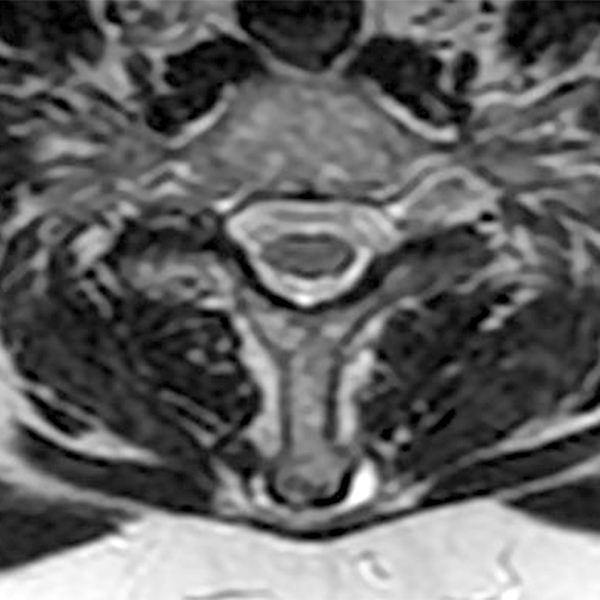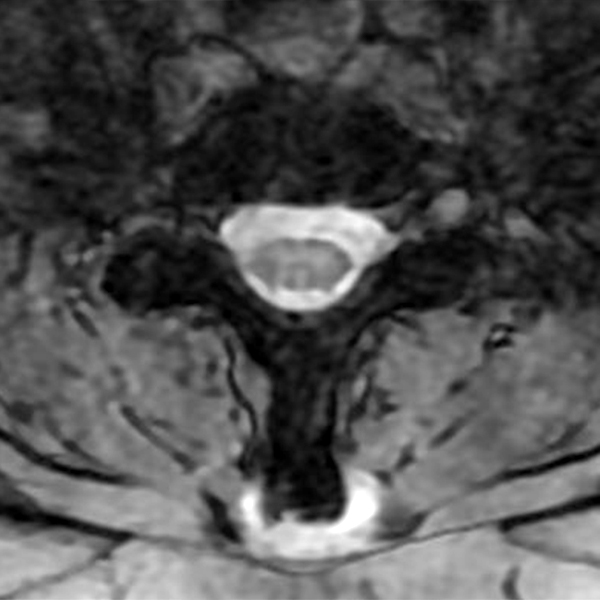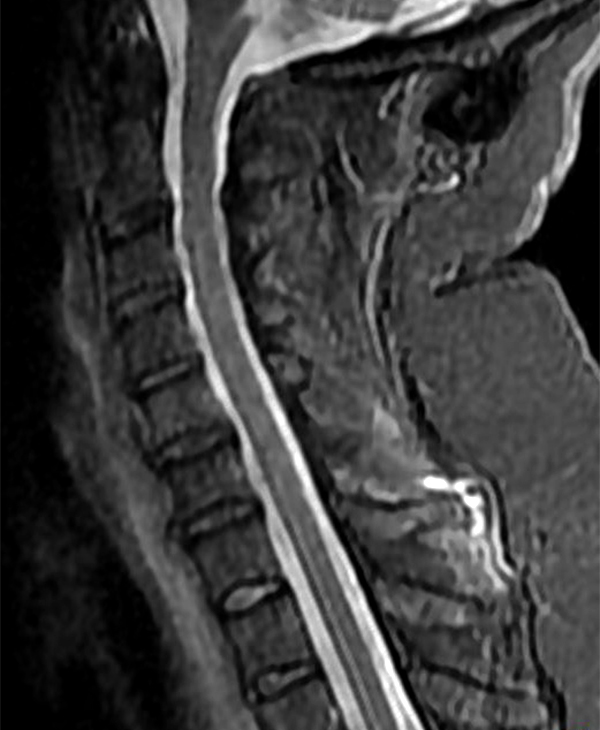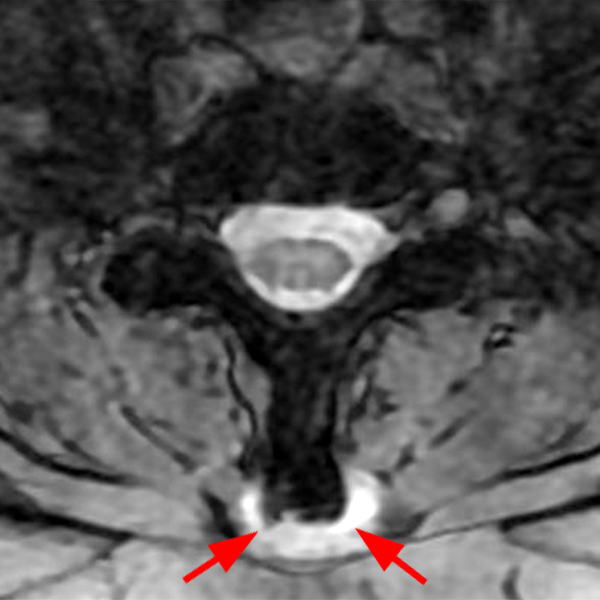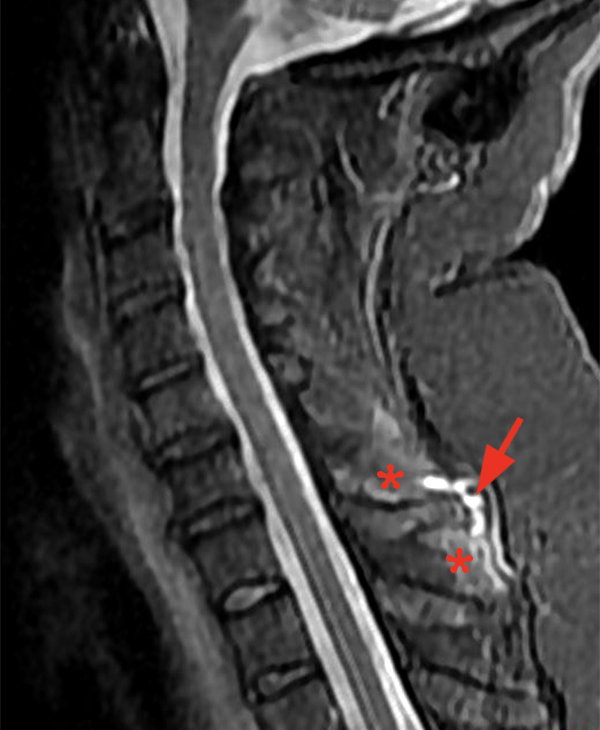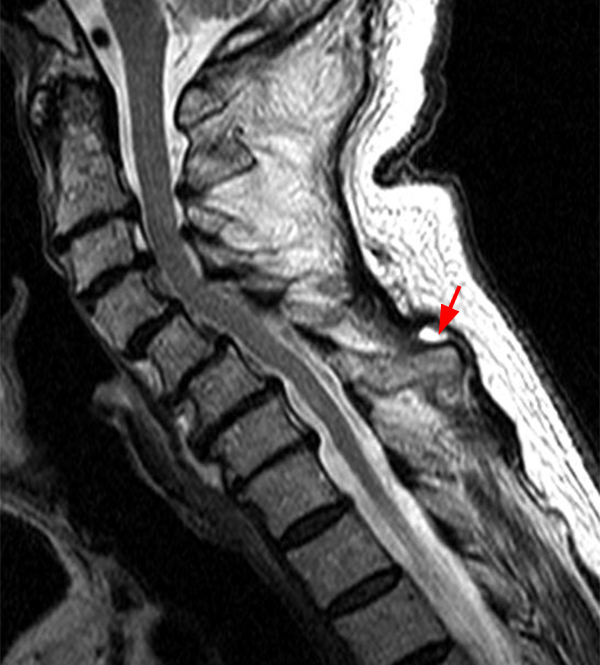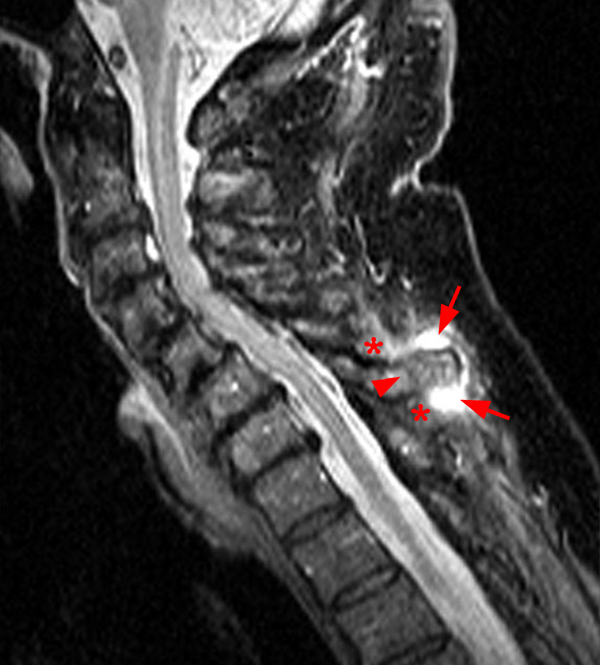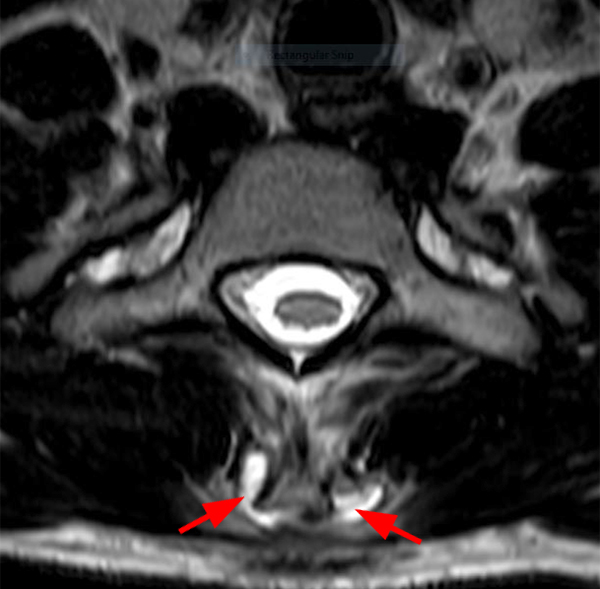Clinical history: A 51-year-old woman presents with neck pain radiating into the arms. Axial T2 (1A) and T2*-weighted (1B) and sagittal STIR (1C) images are provided. What are the findings? What is your diagnosis?
Findings
Diagnosis
Cervical interspinous bursitis
Introduction
Neck pain and radiculopathy are common clinical indications for cervical MRI. Although degenerative disc and facet disease are the most frequently seen findings, interspinous bursitis is a less common and sometimes overlooked etiology of pain. Small bursae are present in the cervical spine in about 50% of adults in the interspace between the spinous processes, more commonly seen when the spinous processes are closely apposed. These bursae can become a source of inflammation in several disease states, including polymyalgia rheumatica (PMR), calcium pyrophosphate deposition disease (CPPD), psoriasis, and adult or juvenile onset rheumatoid arthritis.1,2 As a result of these conditions, the bursae and adjacent interspinous ligaments can become inflamed and symptomatic. In an imaging study of 12 patients with PMR, cervical interspinous bursitis was present in all subjects and was significantly more frequent than in the control group.3 A high prevalence of imaging findings of bursitis without pain is also seen in patients with PMR.4
Clinical presentation
Cervical interspinous bursitis can present as dull, constant, non-radiating midline pain after prolonged activity, especially activities involving hyperextension of the neck. The pain can mimic radiculopathy or meningitis.5,6 Some patients may also present with point tenderness over the area of the bursitis. Pain can paradoxically improve with movement and worsen at rest and may be relieved by positioning the neck in dorsal kyphosis (thrusting the neck forward).7,8 A history of an inflammatory or autoimmune condition may be present.
MRI findings
A well-circumscribed fluid collection adjacent to the tip and/or superior border of the spinous process is indicative of bursitis; this finding is best seen on T2-weighted or STIR sequences. T2/STIR hyperintensity due to inflammation are also frequently present in the adjacent soft tissues and in the interspinous ligaments and may be seen independent of fluid in the bursa. Nonspecific enhancement after the administration of gadolinium and osseous edema in the tip of the spinous process may also be present.
Figure 3:
68-year-old male with neck pain and radiculopathy. Sagittal T1-weighted image shows soft tissue thickening (arrows) and hypointensity at the tip of the spinous process of T1 (white asterisk). Sagittal T2-weighted and STIR sequences demonstrate a small well-circumscribed fluid collection at the tip of the spinous process of T1 (short arrows), osseous edema in the spinous process (arrowheads), and edema in the interspinous ligament at C7-T1 (red asterisks).
Figure 4:
71-year-old male with right shoulder pain. Sagittal T2-weighted and STIR images and an axial T2-weighted image reveal a small fluid collection at the tip of the spinous process of C7 (short arrows) with mild associated osseous edema (arrowheads), and edema in the interspinous ligaments at C6-7 and C7-T1 (asterisks).
Figure 5:
62-year-old female with neck pain and left-sided radiculopathy, and history of prior ACDF. Axial T2-weighted image demonstrates a small fluid collection at the tip of the spinous process of C7 (short arrows). Sagittal T1-weighted image (5b) shows soft tissue thickening (arrows) with enhancement of the bursa (arrowheads) and the interspinous ligaments at C6-7 and C7-T1 (asterisks) after the administration of gadolinium (5C, fat-suppressed T1-weighted image).
Differential diagnosis
Avulsion fractures involving the spinous process (“clay shoveler’s fracture”) can cause pain with fluid accumulation and inflammation on MRI mimicking an inflammatory bursitis. These findings may be seen acutely or in the setting of a chronic non-union of a spinous process fracture. Plain radiographs or CT can be useful in these cases for detection of a small fracture fragment.9
Figure 6:
15-year-old male with neck pain after a weightlifting injury. Axial and sagittal T2-weighted images show a small fluid collection at the tip of the C7 spinous process (short arrows) with edema in the interspinous ligaments at C6-7, C7-T1, and T1-2 (asterisks), mimicking findings of interspinous bursitis. Plain films reveal a small avulsion fracture of the spinous process of C7 (arrow).
Treatment
Oral or IV anti-inflammatory medications and steroid injections are the usual first-line treatments for cervical interspinous bursitis.10 In cases refractory to standard treatment, surgical resection of the bursa can lead to pain relief.
Conclusion
Cervical interspinous bursitis is a less common cause of neck pain with important treatment and diagnostic implications. Careful attention to the spinous processes and interspinous ligaments is recommended on cervical MRI, especially in patients with a known history of rheumatologic disease who do not have other findings that correlate with their clinical presentation.
References
- Bywaters, EGL. Rheumatoid and other diseases of the cervical interspinous bursae, and changes in the spinous processes. Annals of the Rheumatic Diseases 1982; 41:360-370. ↩
- Kume K, Amano K, Susumu Y, Kanazawa T, Komori H, Hatta K, Kuwaba N. Interspinous Bursitis Evaluation by Ultrasound is Very Useful for Diagnosis of Polymyalgia Rheumatica. Presented at ACR/ARHP Annual Meeting, 11/9/2015. ↩
- Salvarani C, Barozzi L, Cantini F, Niccioli L, Boiardi L, Valentino M, Pipitone N, Bajocchi G, Macchioni P, Catanoso MG, Olivieri I, Hunder GG. Cervical interspinous bursitis in active polymyalgia rheumatica. Annals of the Rheumatic Diseases 2008; 67:758-761. ↩
- Camellino D, Paparo F, Morbelli S, Cutolo M, Sambuceti G, Cimmino M. Interspinous bursitis is common in polymyalgia rheumatica, but is not associated with spinal pain. Arthritis Research & Therapy 2014; 16:492. ↩
- Blecher R, Yilmaz E, Tawfik T, Abdul-Jabbar A, O’Lynnger T, Moisi M, Hart R, Hanscom D, Oskouian R, Tubbs RS, Chapman J. Cervico-thoracic Interspinous Bursitis Associated with Bilateral Upper-extremity Numbness: A Case Report. Cureus Nov. 2017; 9(11):e1897. ↩
- Garcia-Gonzalez E, Baldi C, Guidelli GM, Selvi E. Crowded Dens Syndrome and Cervical Interspinous Bursitis Mimicking Acute Meningitis. Journal of Clinical Rheumatology 9/2013; 19(6):357-358. ↩
- Aarons J. “Cervicothoracic Interspinous Bursitis.” www.paindoctorfortlauderdale.com, 12/28/2014. ↩
- SeekHealthZ Editorial, “Cervicothoracic Interspinous Bursitis.” www.seekhealthz.com ↩
- Murphy RF, Hedequist D. Excision of Symptomatic Spinous Process Nonunion in Adolescent Athletes. The American Journal of orthopaedics Nov. 2015;515-517. ↩
- Gonzalez-Gay MA. The clinical implication of cervical interspinous bursitis in the diagnosis of polymyalgia rheumatica. Annals of the Rheumatic Diseases 2008; 67:733-734. ↩

